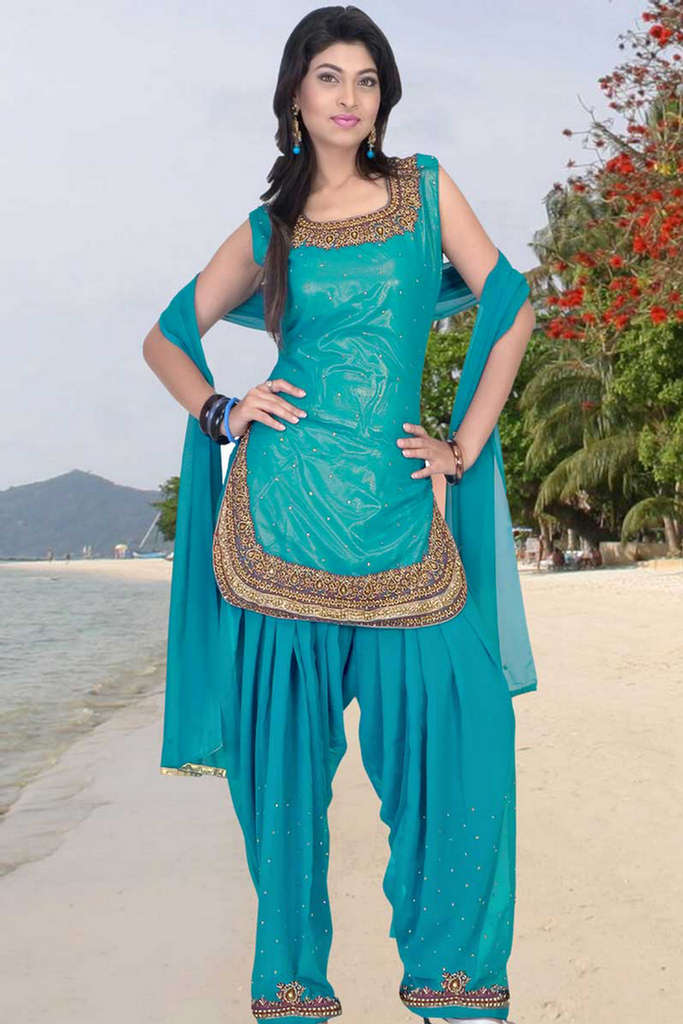Buy Salwar Kameez Biography
Source (google.com.pk)I think that's some anon Pakistani editor who feels that the Indian version of the word is being favored. Just as we had an anon Indian editor who wanted to remove all connection between salwar kamiz and Islamic invaders from Central Asia. People are refighting the Partition over the unlikeliest topics imaginable! I'll remove the ref.I agree that we should favor the vastly more common spelling, but I don't think mentioning the alternate spelling hurts, and I strenuously disagree with eliminating the redirect page, if that's what is being suggested. Redirect pages are virtually free;
I don't think the alternate spelling should be mentioned. The Pakistani I know spells it "Shalwar kamiz" anyways... but, I'm for removing it in the intro but keeping a redirect.
It is interesting how Khat-Partug (Shalwar kamiz) are now either Punjabi, Pakistani or Indian dress code. Khat Partug is the Pashtun/Afghan or "Pathan" dress code. It was known as Pathani in India, and still is known by this name. Punjabis adopted it, and Sikhs adopted after countless invasion by Ahmed Shah Abdali, and later their rule over the Peshawar valley the Sikhs adopted many other customs, Bhangra, a local dance called "Bangray" which means a ring. Bangray or Balbala was is a domesticed version of the Afghan warrior dance ATTAN, whiceh is performed by men before going to war. They also adopted the rooster turban, the type you see today the border guards of India and Pakistan wearing. The Indian/Pakistani dress code are Lungi, Dhoti and Sari. Afghans introduced this type of dress code with their countless rules over a span of 800 years. Iranian, Turks don't wear anything close to Khat Partug, there clothing is more like Arab. From the word "Khata", means dirt, the British invented Khaki (meti color), another dress code that originated during the time of Anglo Afghans wars. Today it is known as Khaki Warde worn by government employees in India. Keray (Pathani Chapal) are now famous in both India and Pakistan. Karakul Afghan hat is also famous, worn by both Jinnah and Hamid Karzai. Pakhtun hat, or Afghan war hat is now famous all over the Muslim world after its famous use in Afghan-Russo war.Shalwar are gathered at the waist and held up by a drawstring or an elastic band. The pants can be wide and baggy or more narrow, and even made of fabric cut on the bias.
The kameez is usually cut straight and flat; older kameez use traditional cuts, as shown in the illustration above. Modern kameez are more likely to have European-inspired set-in sleeves. The tailor's taste and skill are usually displayed, not in the overall cut, but in the shape of the neckline and the decoration of the kameez. Modern versions of the feminine kameez can be much less modest than traditional versions. The kameez may be cut with a deep neckline, sewn in diaphanous fabrics, or styled in cap-sleeve or sleeveless designs. The kameez side seams may be split up to the thigh or even the waistline, and it may be worn with the salwar slung low on the hips. When a woman wears a semi-transparent kameez (mostly as a party dress), she wears a choli or a cropped camisole underneath it.
When women wear the salwar kameez, they usually wear a long scarf or shawl called a dupatta around the head or neck. For Muslim women, the dupatta is a less stringent alternative to the chador or burqa (see also hijab and purdah). For Sikh and Hindu women (especially those from northern India, where the salwar kameez is most popular), the dupatta is useful when the head must be covered, as in a Gurdwara or a Temple, or the presence of elders. For other women, the dupatta is simply a stylish accessory that can be worn over one shoulder or draped around the chest and over both shoulders.
The Shalwar kameez is sometimes known as "Punjabi suit," in Britain and Canada In Britain, especially during the last two decades, the garment has been transformed from an everyday garment worn by immigrant South Asian women from the Punjab region to one with mainstream, and even high-fashion, appeal.
In India, the garment was originally confined to the North, but as a convenient and modest alternative to a sari - and also as one that flatters practically any body-type - it has become popular across the nation. By varying the fabric, color and the level of embroidery and decoration, the salwar-kameez can be formal, casual, dressy, or plain; and it can also be made to suit practically all climates.
Buy Salwar Kameez Designs for Men Women Girls 2013 Pakistani

Buy Salwar Kameez Designs for Men Women Girls 2013 Pakistani

Buy Salwar Kameez Designs for Men Women Girls 2013 Pakistani

Buy Salwar Kameez Designs for Men Women Girls 2013 Pakistani

Buy Salwar Kameez Designs for Men Women Girls 2013 Pakistani
Buy Salwar Kameez Designs for Men Women Girls 2013 Pakistani
Buy Salwar Kameez Designs for Men Women Girls 2013 Pakistani

Buy Salwar Kameez Designs for Men Women Girls 2013 Pakistani

Buy Salwar Kameez Designs for Men Women Girls 2013 Pakistani

Buy Salwar Kameez Designs for Men Women Girls 2013 Pakistani

Comments
Post a Comment